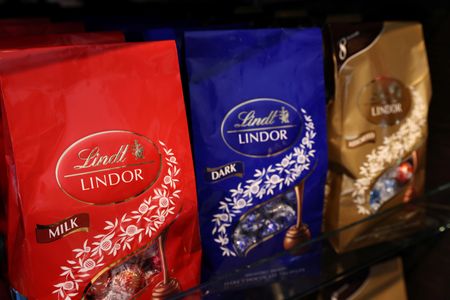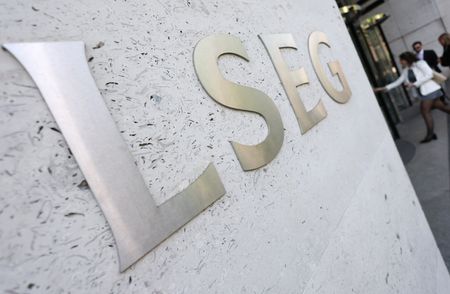By Amir Orusov and Simon Ferdinand Eibach
(Reuters) -Lindt & Sprüngli raised its organic sales growth forecast on Tuesday as European customers kept buying premium chocolates, even as steep price hikes struck its overall volumes in the first half of 2025.
Shoppers continued to bear the brunt of high cocoa prices as Lindt raised prices of its products by another 15.8% in the first half.
The maker of Lindor chocolate balls now expects organic growth of 9-11% this year, after previously guiding for 7-9%.
Its half-year sales grew 11.2% organically to 2.35 billion Swiss francs ($2.95 billion), above analysts’ average estimate of 2.30 billion.
However, its shares fell 5% in early trading, on track for their worst day since March 2020, with analysts from Baader Helvea flagging a clear slowdown in sales volumes that was likely felt most in North America.
“Organic growth was exceptionally strong in Europe but relatively weak in North America. Assuming similar … cocoa-price driven pricing in all regions, one wonders on the volume development in North America,” they wrote in a research note.
While Europe recorded organic growth of 17.7% in the first half, a weak consumer sentiment in North America weighed on sales there, resulting in just 3.6% growth.
Lindt’s January-June operating profit of 259.2 million francs missed market expectations by 4%, dragged by weaker volumes and still high cocoa costs, data collected by LSEG showed.
London cocoa futures have nearly halved after reaching historic highs in 2024, but remain clearly above the historical average.
Lindt continues to evaluate its global sourcing strategy ahead of the expected imposition of new U.S. tariffs on August 1, a company spokesperson told Reuters.
It produces 95% of the chocolates it sells in the U.S. at its five factories in the country, which also supply less than half of the products sold in Canada.
Lindt had said in March it would supply chocolate made in Europe to Canada to avoid reciprocal tariffs on U.S. goods, but later said it had not adapted the strategy yet, after several changes to tariffs placed on U.S. imports and exports.
($1 = 0.7975 Swiss francs)
(Reporting by Amir Orusov and Simon Ferdinand Eibach in Gdansk, additional reporting by Anastasiia Kozlova and Anna Pruchnicka; editing by Milla Nissi-Prussak)








